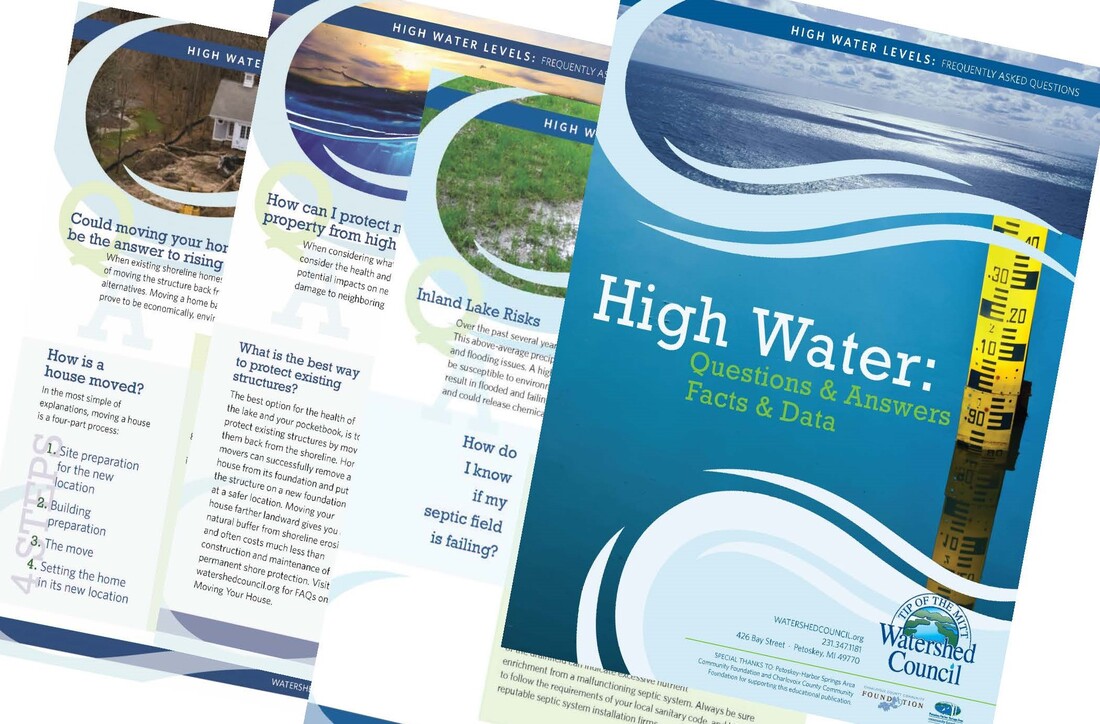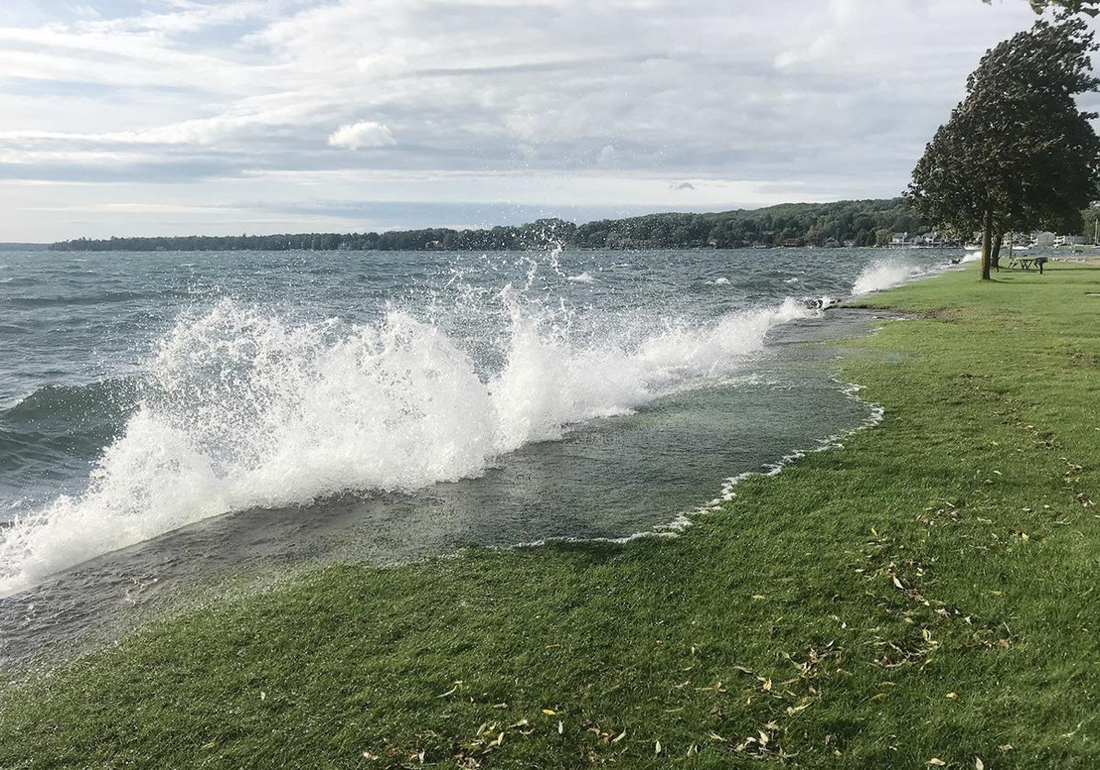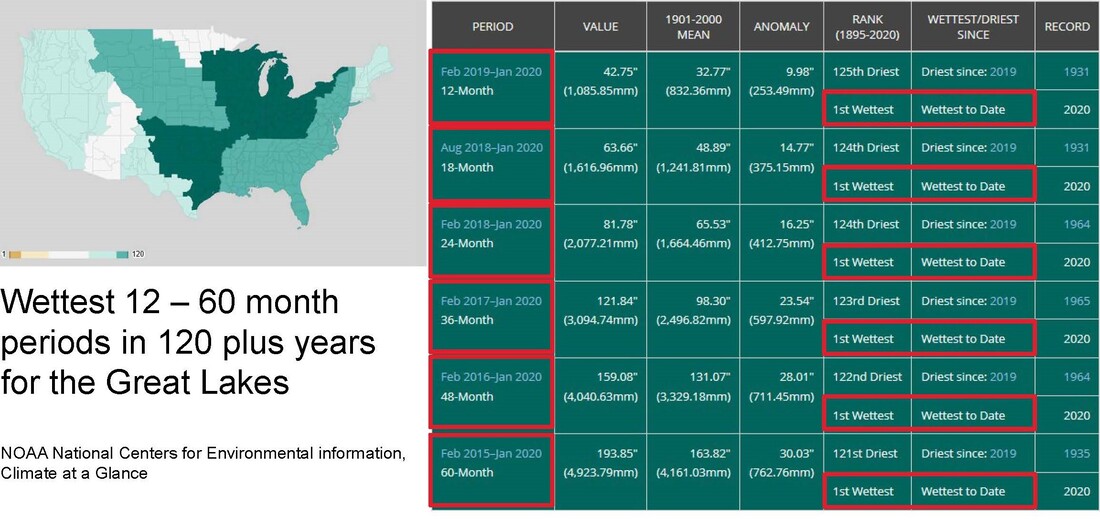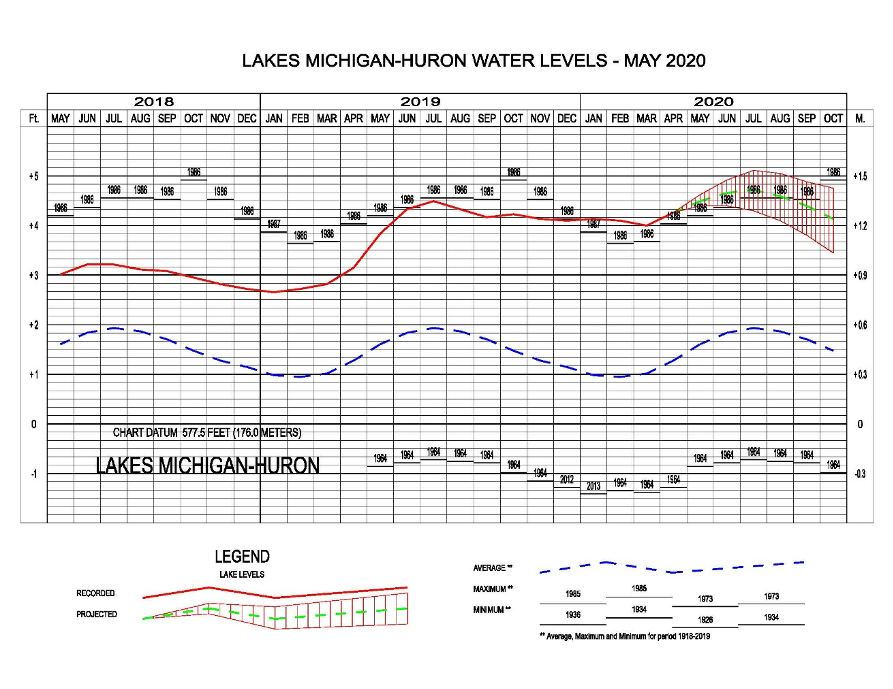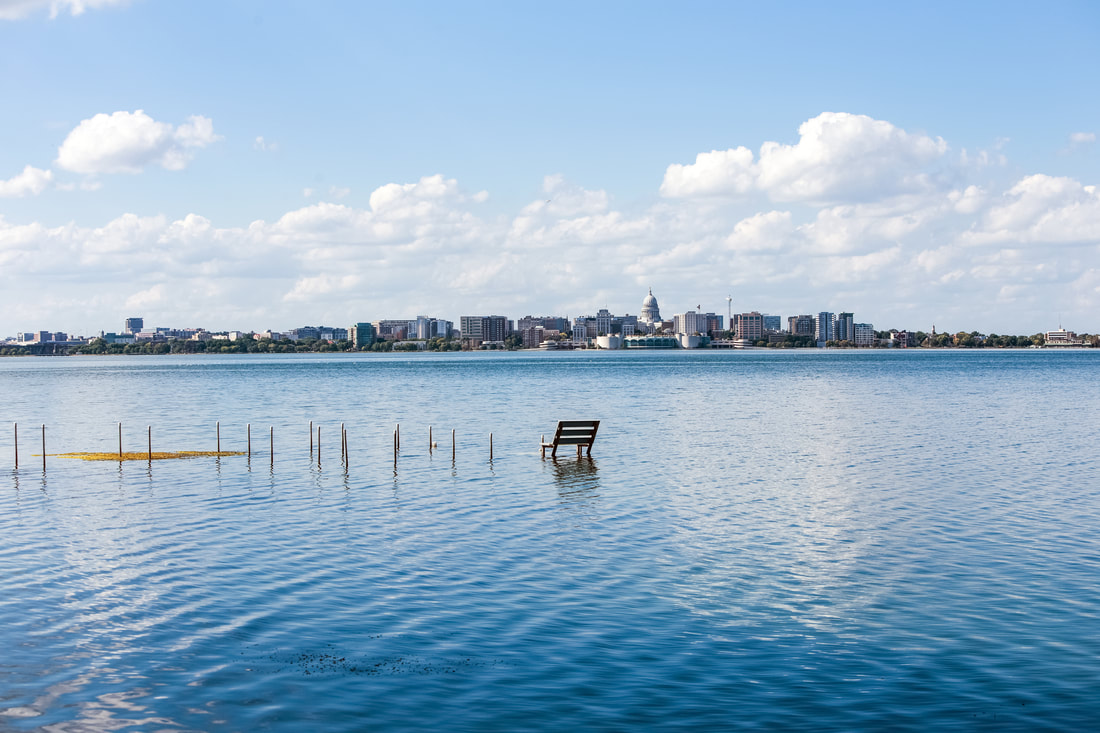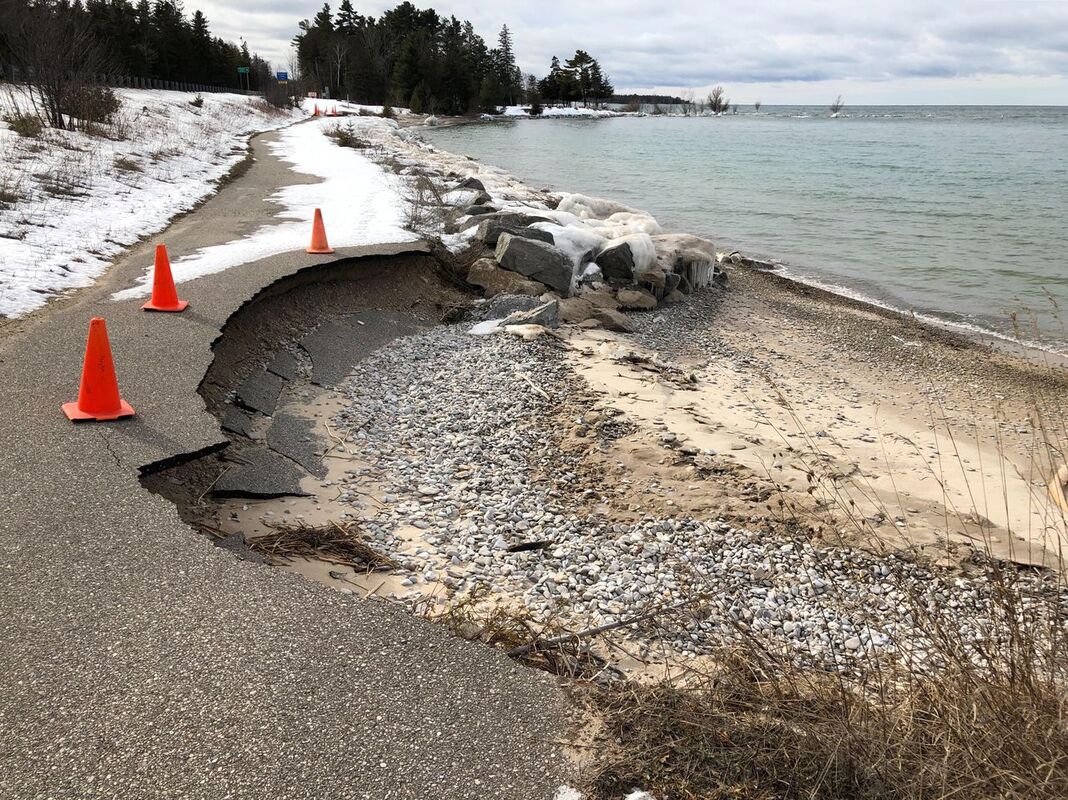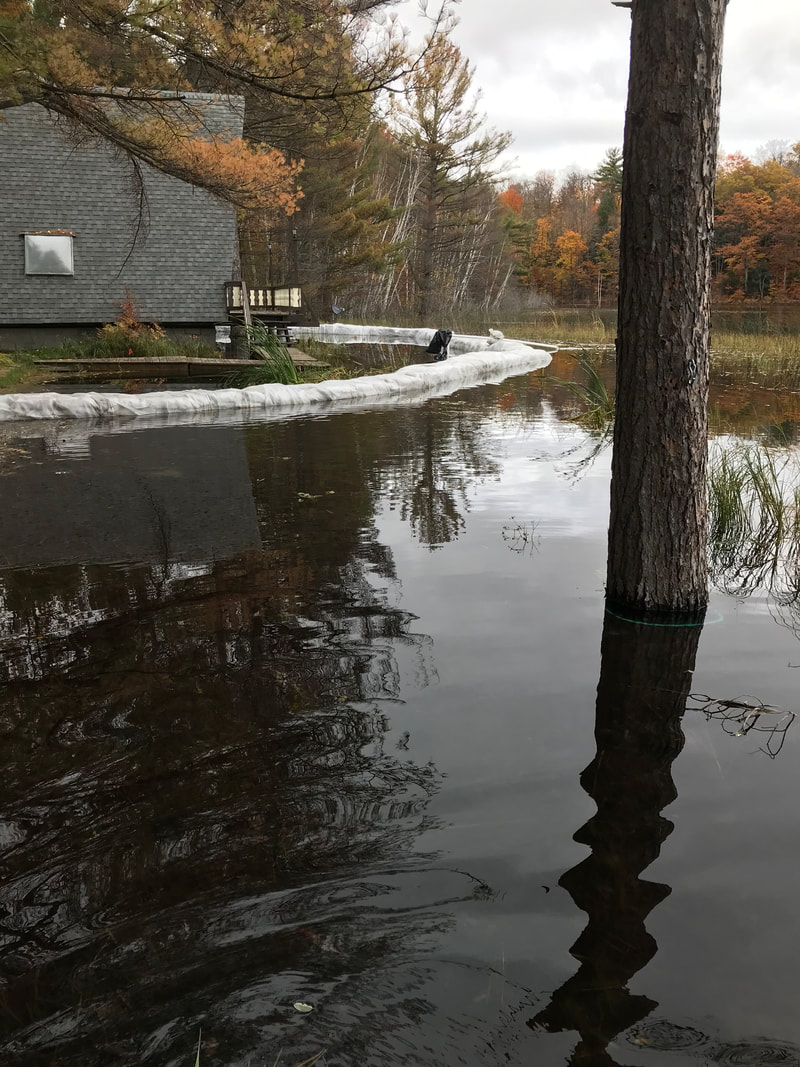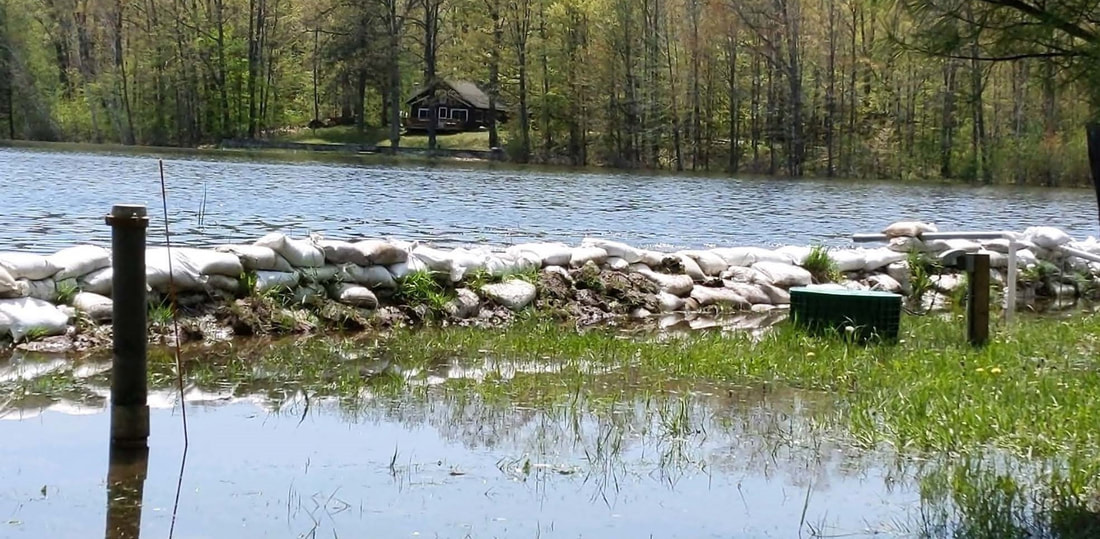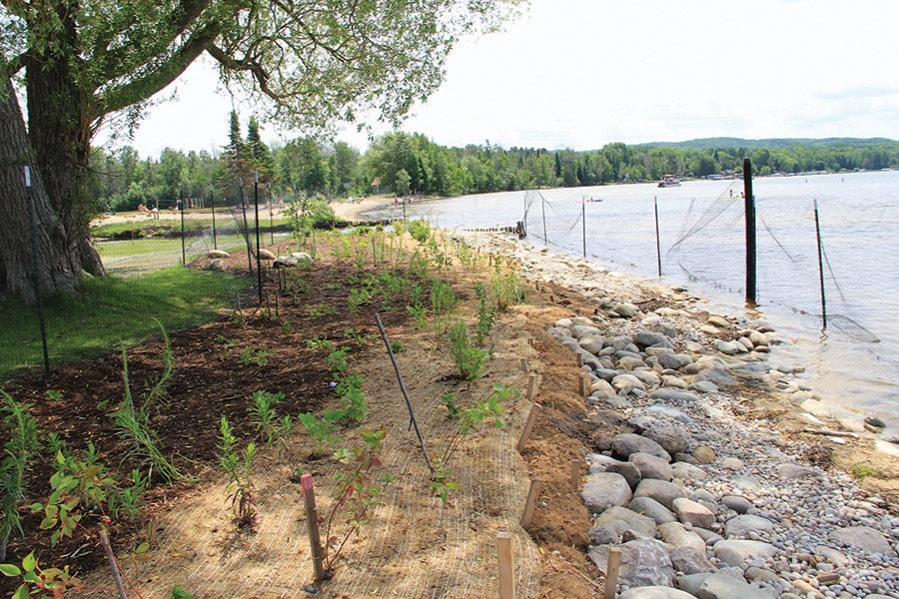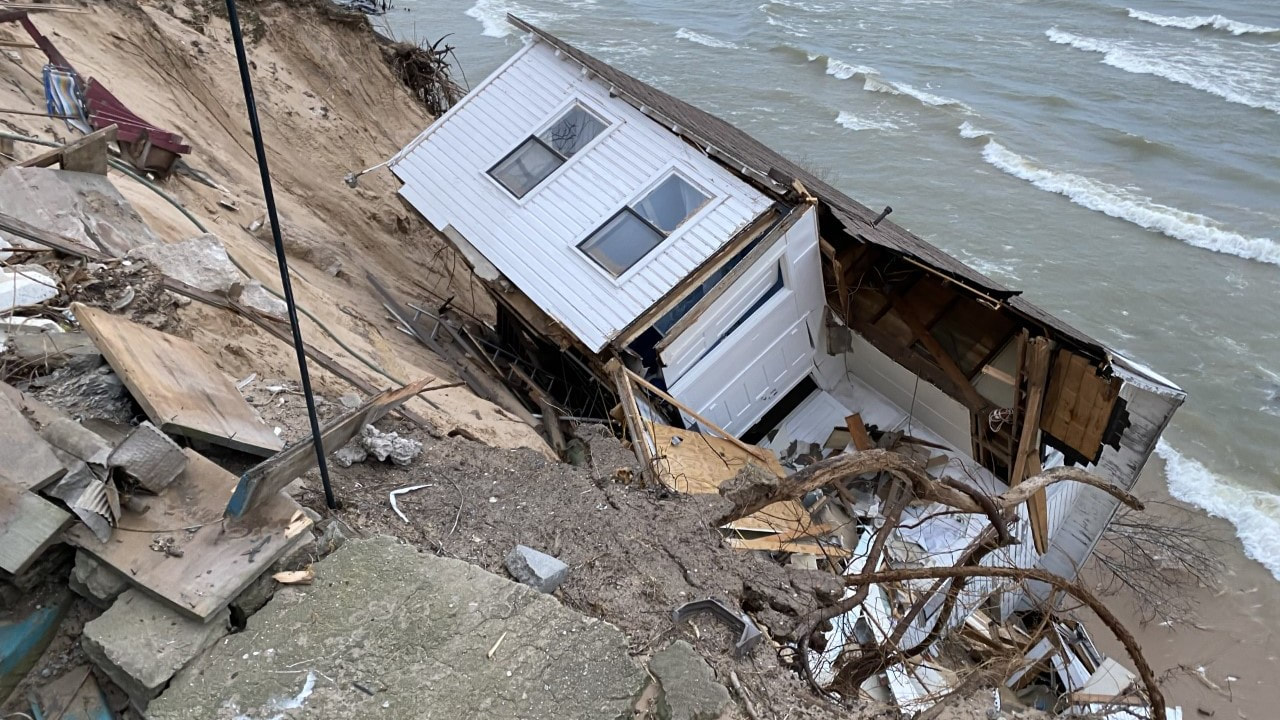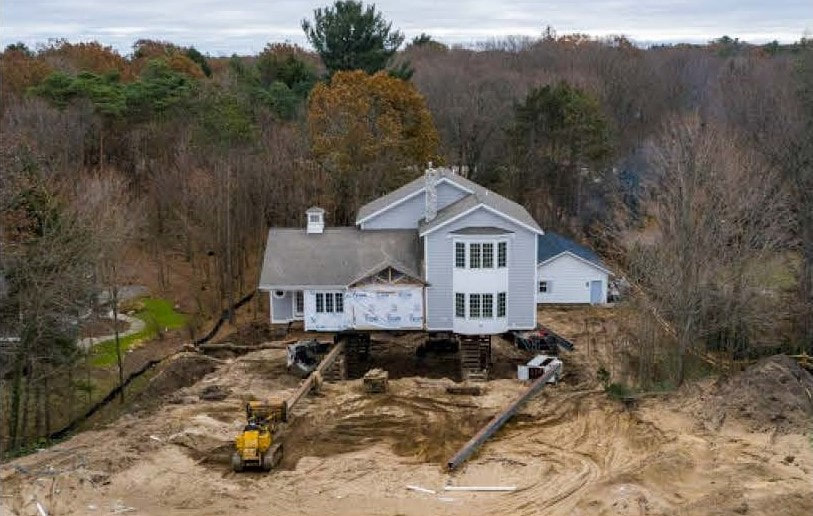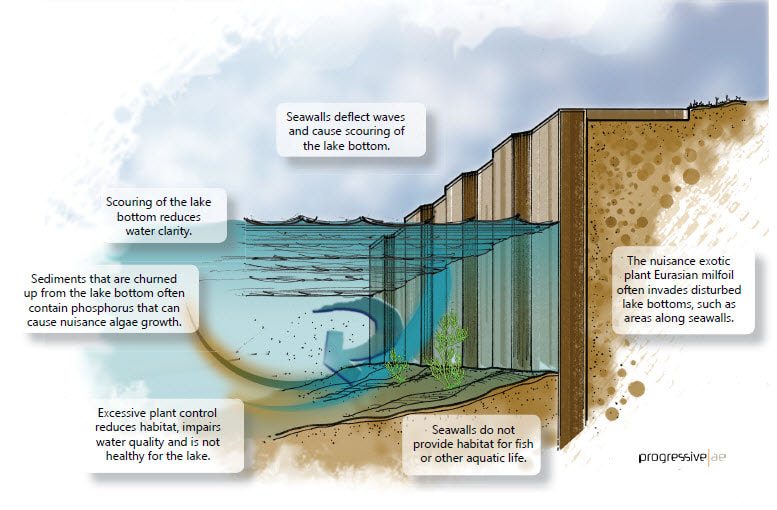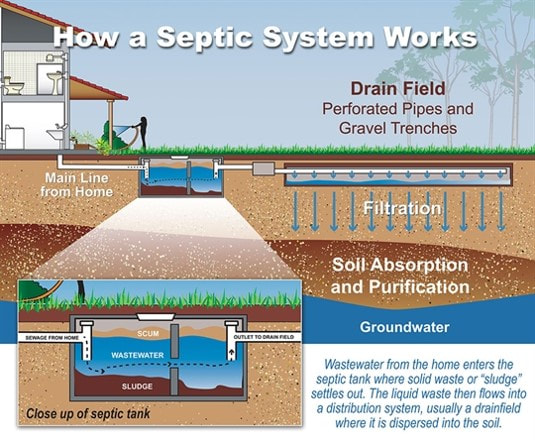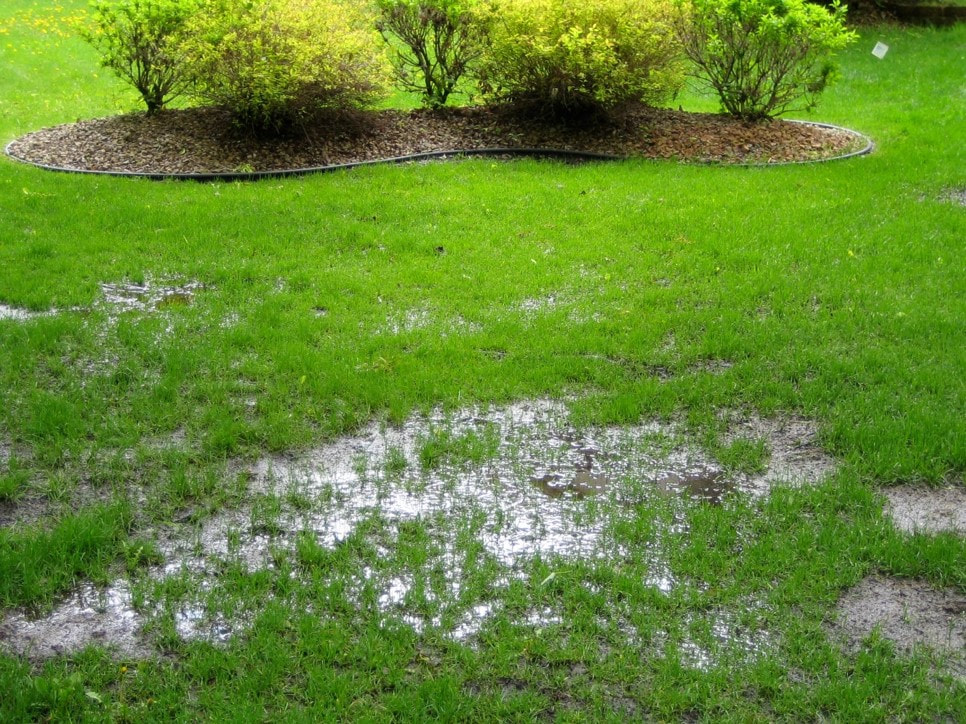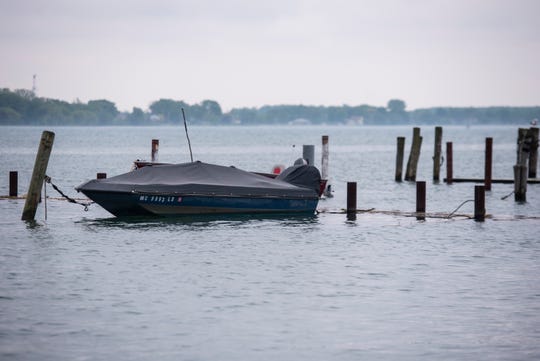The Great Lakes are experiencing the highest water levels since 1986. Lake Superior, Lake St. Clair, Lake Erie and Lake Ontario set new record high water levels over the summer of 2019. Lakes Michigan and Huron have reached monthly mean record high levels in January, February, and March 2020. |
It is projected that Lakes Michigan and Huron will remain above the monthly record high water levels through August 2020, by approximately 1-5 inches. All of the other Great Lakes are expected to peak below 2019 levels.
Erosion and Shoreline Protection FAQ
When considering what actions to take along the shore to combat high waters, it is important to consider the health and the dynamic variability of the both the Great Lakes and inland lakes and the potential impacts on neighboring property. Excessive or poorly designed structures can increase damage to neighboring properties and disrupt natural processes along the shoreline.
For example, sandbags are not an effective solution for long-term shore protection. Sandbags are not a preferred method of protecting against erosion as the bags are temporary; they cannot withstand wave energy or ice movement. The bags break open and become litter that impacts water quality and wildlife on the shoreline and in the lake; they slump and cannot hold the slope; and shoreline erosion continues.
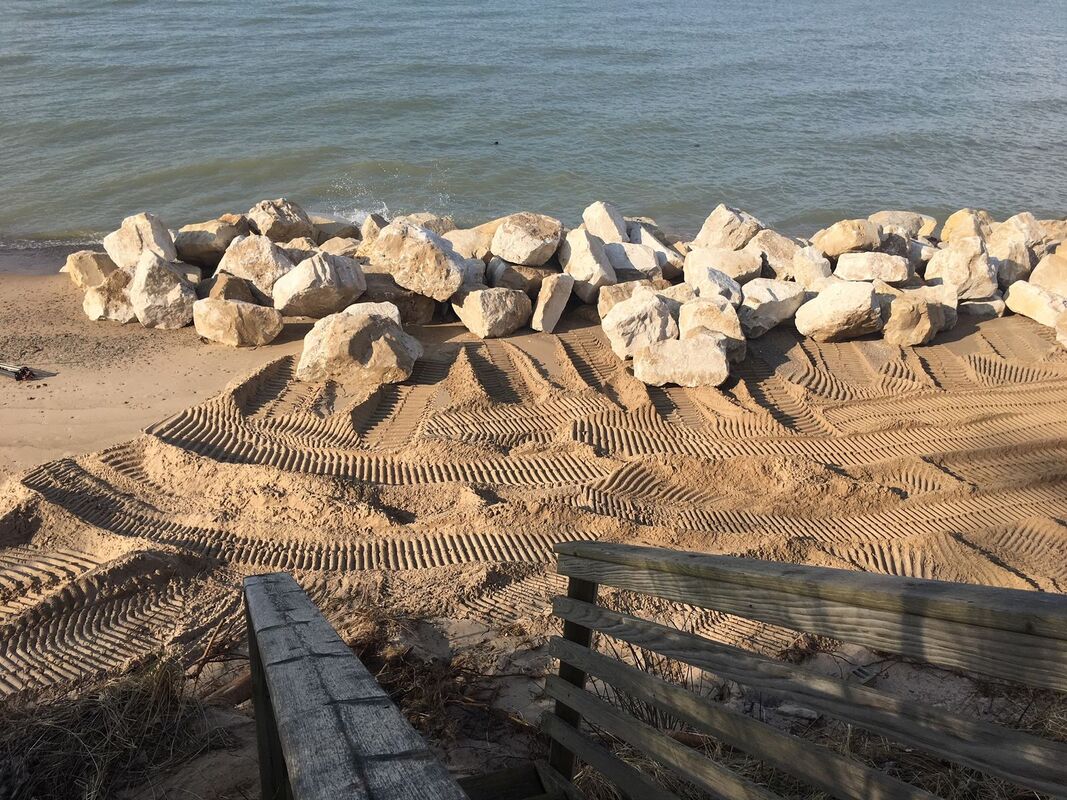
The best option, for the health of the lake and your pocketbook, is to protect existing structures by moving them back from the shoreline. Home movers can successfully remove a house from its foundation and put the structure on a new foundation at a safer location. Moving your house farther landward gives you a natural buffer from shoreline erosion and often costs much less than construction and maintenance of permanent shore protection. See FAQs on Moving Your House.
Another option for inland lakes is bioengineering. Bioengineering is a form of erosion control that incorporates biological, ecological, and engineering concepts to produce a living, functioning shoreline system through the use of live and dead plant material, native soils, and structural materials. It can be used to restore a shoreline where native vegetation has been removed. Bioengineering provides fish and wildlife habitat and water quality benefits that may be lost with other stabilization methods. It can be designed in conjunction with riprap for high energy systems, allowing the shoreline to be stabilized while providing additional benefits to the lake ecosystem.
Bioengineering is usually less expensive than structural methods like concrete seawalls. Some applications can be done by the homeowner while other applications will require a contractor. The estimated cost of installing a natural shoreline, including bioengineering materials, averages from ten to twenty dollars per linear foot. The financial cost of hard armoring the shore (using seawalls and bulkheads) can range from forty-five to two hundred dollars and up per linear foot. Contact the Watershed Council for guidance and recommendations with respect to developing plans for an appropriately-designed bioengineered shoreline.
To install shoreline protection on the Great Lakes, you will need a permit from both the Michigan Department of Environment, Great Lakes, and Energy (EGLE) and the United States Army Corps of Engineers (USACE). Only one application is needed for both agencies; however, the permits are issued separately. For inland lakes, a permit is only needed from EGLE. The Joint Permit Application is submitted through https://www.michigan.gov/egle/maps-data/mienviroportal. Other local regulations may also apply. Many shore protection projects qualify for expedited review under general permits. In addition, permits will be expedited, often within a matter of days, if a house or critical infrastructure is in immediate danger due to high water levels. EGLE can also issue emergency conditional permits when needed to protect the public health, safety, or welfare. These emergency permits are often granted the same day they are applied for. It is important to note that if there is not active and ongoing erosion onsite, a permit should not be approved for modification of the shoreline, as this would be to the detriment of the environment, public trust, and riparian interests of adjacent owners.
It is also recommended that anyone considering a shoreline protection project contact EGLE prior to submitting a permit application. Shoreline property owners can request a pre-application meeting with EGLE Water Resources Division staff. A pre-application meeting can provide landowners with a written copy of EGLE’s findings regarding the need for a permit along with any other written comments or suggestions such as ways to avoid impacts to aquatic resources. You can contact EGLE’s Water Resource’s Division Gaylord District Office at 989-731-4920.
Contact the ELGE Assistance Center (EAC) at 800-662-9278 or EGLE-Assist@Michigan.gov, if you have questions or need assistance. The EAC is staffed Monday to Friday from 8:30 a.m. to 4:30 p.m. Tell the operator that you are calling about shoreline erosion and you will be transferred to a field staff person. After hours, please leave a message and someone will get back to you the next business day.
EGLE also has a website available: www.Michigan.gov/HighWater
USACE has a water levels webpage. Visit https://www.lre.usace.army.mil/Missions/Great-Lakes-Information/Great-Lakes-Information.aspx#ICG_ETH_22302
When existing shoreline homes are threatened by high water and erosion, the costs and benefits of moving the structure back from the lakeshore should be weighed along with other alternatives. Moving a home back can compare favorably to other alternatives and prove to be economically, environmentally, and aesthetically better in the long run.
How do you move a house?
In the most simple of explanations, moving a house is a four-part process:
1. Site preparation for the new location
2. Building preparation
3. The move
4. Setting the home in its new location
What does the process of moving a house look like?
Before the big move, there’s a punch list of items for the professionals, but the homeowner can leave the house’s contents alone. To begin the project, the homeowner will need to work with a general contractor. The general contractor will help with site and building preparation and other aspects of the move including obtaining permits, disconnecting and reconnecting utilities, excavation, and laying the new foundation. The utilities must be shut off and disconnected from the house, including electric, water, sewer/septic, gas, telephone, cable, etc.
Depending on the size and shape of a home, the actual moving of the structure can be completed within a day or two. If the situation is dire for a property owner, the home can be moved before the new foundation is laid, although this will increase the cost. Digging the hole for the foundation in advance could decrease the cost, but it depends on how long it takes to get the foundation poured. Homes can be moved back on the same lot or if there is not enough room, houses can be relocated to a new lot.
How much does moving a house cost?
As you might imagine, moving a house is not a “flat fee” type of service. There are many factors that go into the pricing of a home move, including square-footage, as well as the structure’s length, width, weight, and construction method (modular vs. stick built, etc.). Accessibility, move distance, and other obstacles (e.g., power lines, accessibility, structural integrity) also factor into the cost to move a home or building. Garages, additions, porches, decks, balconies, chimneys, fireplaces, and other accessories can almost always be moved with the house, but add time and increase the project cost.
The total cost of moving a home ranges from as little as $12,000 for a ranch up to $100,000, or potentially more, for larger more complex sites. On average, costs for the industry seem to land between $12 and $16 per square foot.
For property owners located on islands, such as Beaver Island, there may be increased costs due to getting the necessary equipment to the island, if there is not a contractor on the island available. To reduce costs, it is recommended to work with neighbors and other shoreline property owners on the island to coordinate moving back homes. Bringing equipment over to the island for multiple jobs will defray the costs for all parties.
The Michigan Department of Environment, Great Lakes, and Energy (EGLE) compiled a small list of home movers that work in the State of Michigan. This list is not comprehensive and listing or omission of a company does not imply endorsement or disapproval. Neither EGLE nor Tip of the Mitt Watershed Council makes any endorsement or representation of any qualifications by any of the listed individuals or companies.
How do I get a quote on the cost of moving my house?
One local house mover in Northern Michigan is J&R Building Movers, located in Petoskey. To get a quote, email pictures of your house from all sides, as well as a photo from the distance showing the lay of the land, and information about the house, including dimensions and address to jandrbuildingmovers@outlook.com.
An initial estimate can be provided and then J&R Building Movers will schedule a time to conduct a site visit to the property. A site visit costs $500. The $500 will be deducted from the overall price of moving the house, should you choose to contact with J&R Building Movers.
Moving structures away from eroding shorelines is a longer-term solution than installing and maintaining shoreline protection. Shoreline armoring can adversely affect the health of the Great Lakes as well as neighboring properties. As waves hit the large boulders or concrete seawalls, the energy from the waves does not disappear. This energy is directed downwards and sideways. The energy that is directed down erodes the lake bottom. Scouring of the lake bottom increases with lake size and wave height, causing a loss of habitat. In addition, seawalls cause wave flanking in which the wave energy is also deflected sideways to neighboring property. This causes erosion on your neighbor’s property where there might not have been any erosion.
Hardening the shoreline, through riprap or revetments, can alter sand movement and water currents. Because shore parallel structures prevent some exchange or movement of sand in a local area, depending on the positioning of the wall, the beach in front of that structure may actually be narrower. That is a result of greater reflection of the wave off the structure. There may also be additional starvation of the beach downdrift of the structure.
Furthermore, once a bluff or beach is reinforced, it is an ongoing financial investment to maintaining the structure, which will be battered and worn down by the lake over time.
It is also important to note, a homeowner is responsible for any damage caused to neighboring properties from their individual actions. So if a seawall or riprap is installed incorrectly or fails and causes erosion of your neighbor’s property, you are civilly liable for the damages your actions caused. In addition, any property owner whose house does fall into the lake is responsible for cleaning up all debris.
In the long-term, moving a house can often be better for your pocket book, your neighbors, and the Great Lakes.
Flooding Risks
Over the past several years, Michigan has received a record-breaking amount of precipitation. This above-average precipitation has resulted in many areas of Michigan experiencing high water and flooding issues. A high groundwater table means that inland lakes and their residents could be susceptible to environmental contamination and public health risks. Inland flooding could result in flooded and failing septic systems and drainfields, contaminated drinking water wells, and could release chemicals or fuels from flooded basements and garages into our waters.
It’s important for shoreline property owners to properly maintain their septic system. Septic systems that are failing or unmaintained can threaten both surface and ground waters. Studies have shown that some pollutants carried by groundwater beneath the septic system often reach surface waters from septic systems located within 300 feet of the shoreline. Nutrients, such as nitrogen and phosphorus, are the primary pollutants of concern. Nutrients can encourage excessive aquatic plant and algae growth, which can make swimming and boating undesirable. Septic system effluent can also contain disease-causing bacteria that can move to surface waters from septic systems, making it unsafe for swimming or other bodily contact. Contamination of groundwater from septic system effluent is a particular concern where the groundwater is used for drinking water. Because shoreline areas typically have high water tables and septic systems are often very close to the water, the potential to negatively impact groundwater and surface water from a failing septic system is significant.
- Have your septic tank inspected and pumped regularly by a licensed pumper. The general recommendation for how often to get your tank pumped is once every 3 to 5 years. Of course, the right pumping schedule for you is based on the size of the septic tank, the number of individuals in your household, and the amount of wastewater generated. Heavy or year-round use requires more frequent pumping than light or seasonal use.
- Consider improving or upgrading your system if the amount of wastewater you generate is more than your septic system can handle. Since it is not easy to make such extensive changes, carefully consider all of the activities that generate wastewater in your home – cooking, bathing, flushing toilets, doing laundry, dishwashing, etc. This will help you come up with measures you can take to conserve as much water as possible.
- DO NOT use commercial products that claim to be a substitute for maintenance pumping. Many of these products liquefy the sludge and cause it to enter the drainfield.
- Avoid using chemicals, such as drain cleaner and large amounts of bleach, because they kill the bacteria that break down solid wastes in the septic tank.
- Install a vegetative buffer strip of deep-rooted plants between the end of your drainfield and the shoreline area. These plants can help absorb nutrients before they reach water. Be mindful not to plant deep-rooted plants in the area directly over your drainfield, as roots might cause damage to your system, which may result in wastewater that is not adequately treated.
- Direct rainwater from gutters and other surface runoff away from the drainfield. Excessive moisture can saturate the soil and reduce the drain field’s filtering capacity.
- Construct the septic system as far away from the shoreline as possible if you are building a new home. Never build or pave over a drain field. Keep vehicles away from the drainfield and septic tank.
- DO NOT apply fertilizer around a drainfield because the nutrients saturate the soil and cause it to stop removing nutrients from the wastewater.
- Limit your use of kitchen garbage disposal units. Heavy use adds large quantities of solids to your septic system and will shorten the time between septic tank maintenance.
- Practice water conservation in all areas of the home. Some water conservation practices that will pay off big time for your septic system:
- Install low–flow faucet aerators and showerheads. Using these low-flow devices is the best water conservation action to take and usually the cheapest.
- Do laundry one load daily instead of all loads in one day. This reduces the amount of water going into the system at one time.
- Fix leaky faucets and toilets to reduce the amount of water going into the system. Studies show that leaks account for more than 10% of the household water used.
- Only run the dishwasher when there’s a full load.
- Use the garbage disposal sparingly. Disposers require a lot of water to run properly.
- Don’t run the washer, the dishwasher and take a shower at the same time to reduce overloading the system.
- Do not connect sump pumps to the septic system. This will prevent water that does not need treating from going into system.
- Do not water the grass over or around the drainfield. The field gets enough water from household use and does not need any additional water from lawn watering.
Toilets or sinks backing up or draining slowly in spite of using plungers and drain cleaners may indicate that drainfield soils are becoming saturated. Wet areas, lush grass, or foul odors around the drainfield indicate that effluent is surfacing, and these are all warning signs that your septic system is not functioning properly. In shoreline areas, noticeable algae and plant growth or a distinctly colored patch of bottom sediment developing in the general vicinity of the drainfield can indicate excessive nutrient enrichment from a malfunctioning septic system.
Remember that a permit from the local health department is required for repair, replacement, or new construction of a septic system. Always be sure to follow the requirements of your local sanitary code, and hire only reputable septic system installation firms.
Ensure your septic system is functioning properly so it doesn’t contaminate your drinking water well. If the casing on your well becomes submerged, your drinking water can become contaminated. The casing should extend at least 12 inches above the ground for sanitary protection. If you do not have at least 12 inches of casing above ground, you do not have the same degree of protection from surface contamination. Well casing can easily be extended to ensure this minimum depth. You can also consider having a well contractor install a watertight cap on your wellhead. If a well becomes submerged in surface water, do not drink the water or use it for brushing your teeth. If water has reached your well or is covering the top of your well casing, assume your well is contaminated. Health risks can occur from a contaminated well. Bacteria such as E.coli and rotavirus can be found in contaminated water, along with deadly substances like lead and nitrates. If contaminated, have your well disinfected as soon as possible and tested to ensure it is safe. The Health Department of Northwest Michigan has test kits available for many types of water sampling, including the two most common: Bacteriological and Partial Chemical, which tests for hardness, fluoride, chloride, iron, sodium, sulfates, nitrites and nitrates. You can stop by any of the health department offices to pick up one or both of the test kits. Simply collect your water sample and drop it off the same day to any of the four Environmental Health offices in Bellaire, Charlevoix, Harbor Springs, or Gaylord. They will ship it to the laboratory in Gaylord at no extra charge. Samples MUST be collected on the day they are dropped off. Drop offs will only be accepted on Monday, Tuesday, and Wednesday mornings between 8 am and 11 am at all four locations. For more information, visit http://nwhealth.org/homeowners.htm |
What are other concerns from high waters?
Electric shock drowning is an increased risk due to high water levels. Water-overtopped docks may have electrical hook-ups that have the potential to shock someone who comes in contact with the water. People should avoid swimming off of docks and piers that are wired with electricity. The water around a dock could be carrying lethal amounts of electricity even if the electrical source is hundreds of yards away.
Walking through a wet or flooded basement can also be extremely dangerous. Never walk through a flooded basement until the electricity is disconnected. Even a small amount of water on a basement floor can put you at risk for electrocution.
Shoreline property owners in areas that are likely to flood should move hazardous household materials to a safe area that is likely to remain dry. Items should be moved to higher ground because they pose a danger if their contents are released into the environment. Examples of items that should be moved to safer and drier areas include: vehicle batteries, propane tanks, drain cleaners, motor-vehicle oil, antifreeze, pesticides, and fertilizers.
What resources are available to help me with high water issues?
- Michigan Department of Environment, Great Lakes, and Environment www.Michigan.gov/EGLEHighWater
- U.S. Army Corps of Engineers https://www.lre.usace.army.mil/About/Great-Lakes-High-Water/
- Health Department of Northwest Michigan http://www.nwhealth.org
- Frequently Asked Questions (FAQ): Septic Systems and Flooding Events developed by EGLE Drinking Water And Environmental Health Division Onsite Wastewater Program
- Guidance for Septic Systems Before, During, and After a Flood developed by the National Environmental Health Association (NEHA).
- Protecting Your Private Water Supply In An Emergency developed by EGLE Drinking Water and Environmental Health Division

